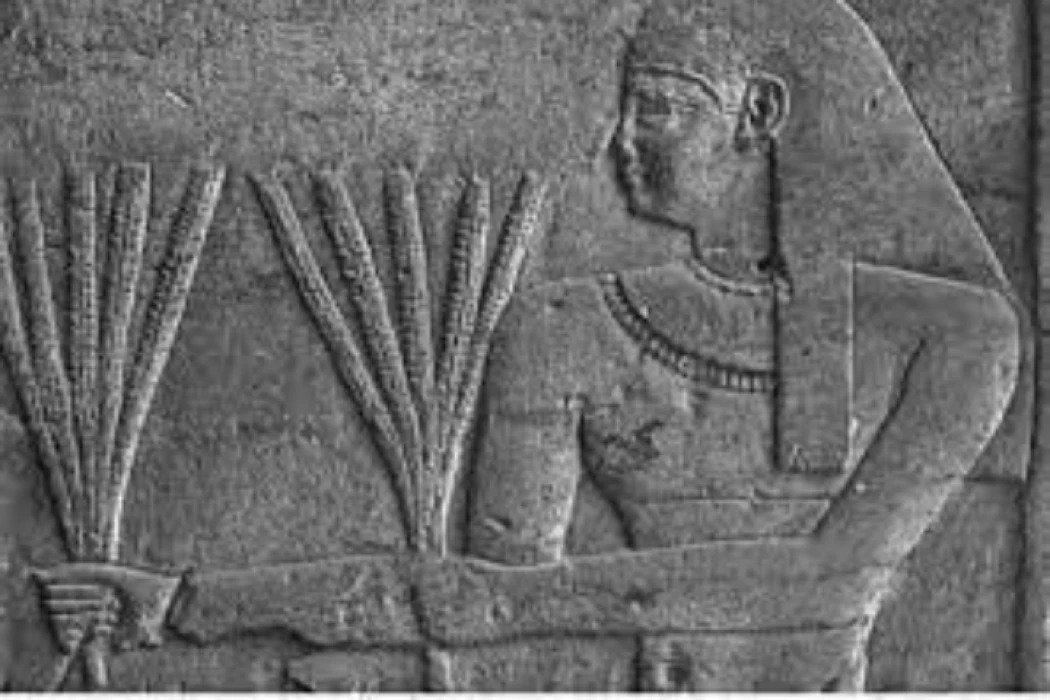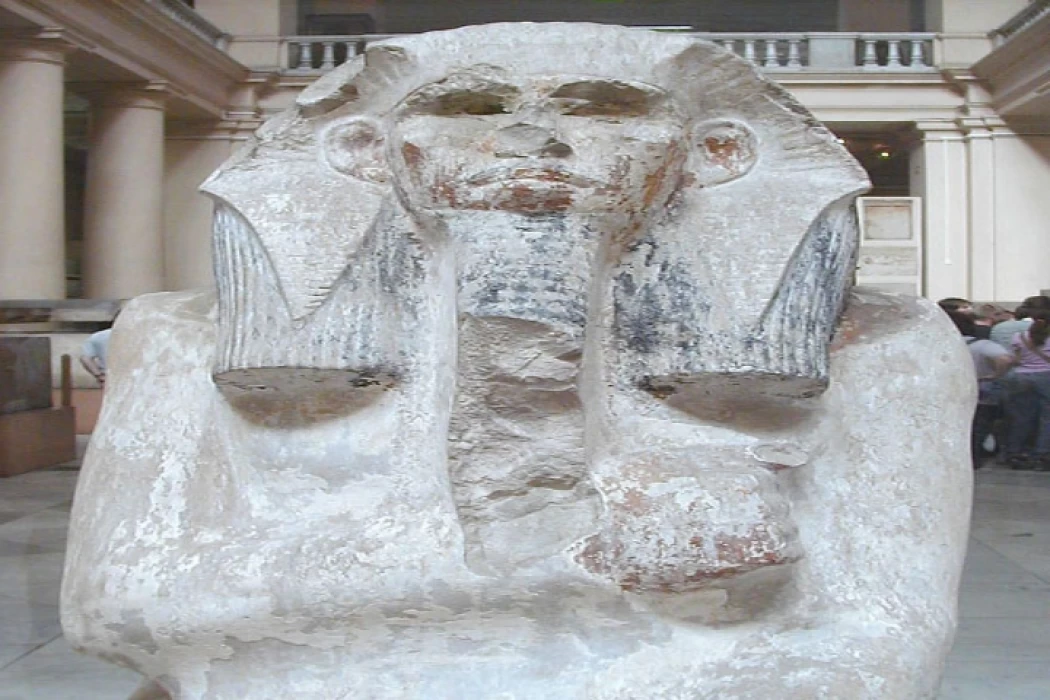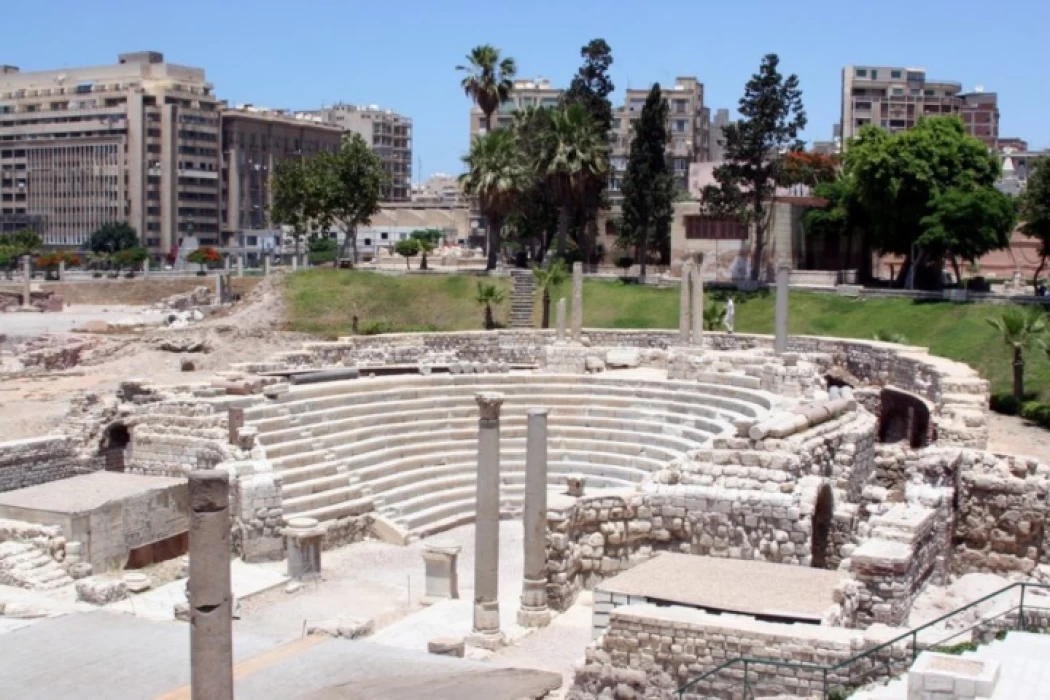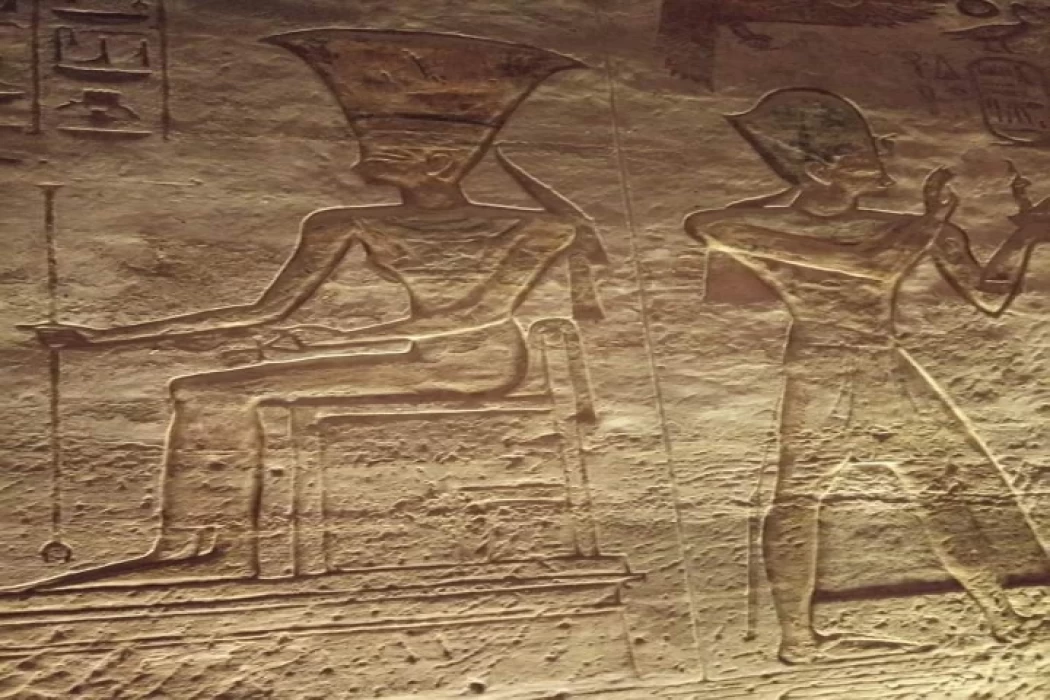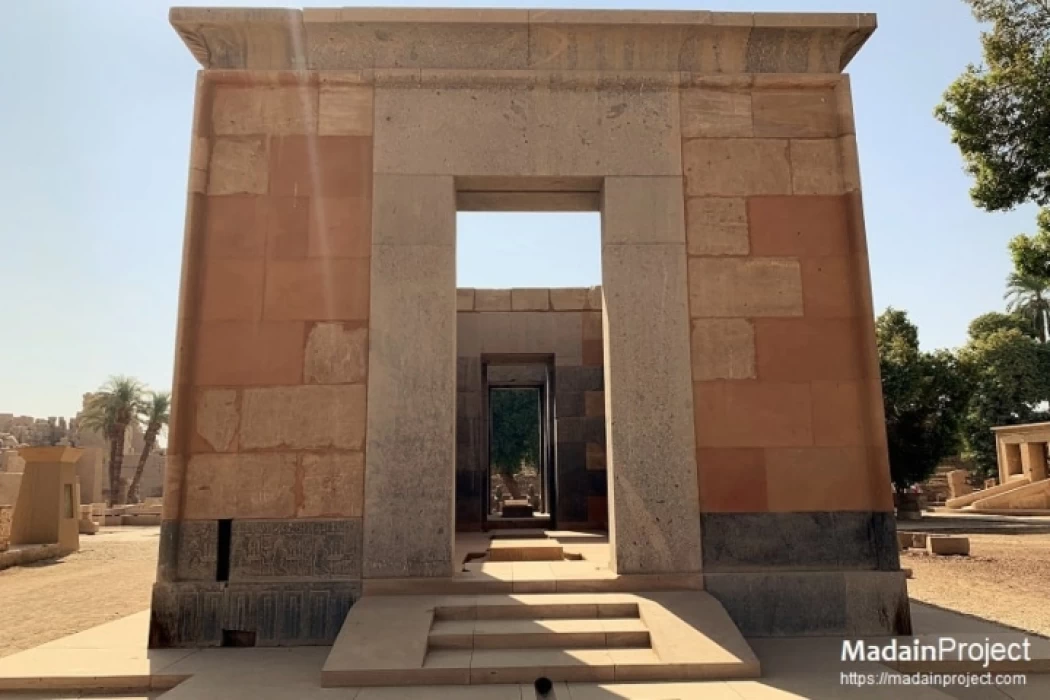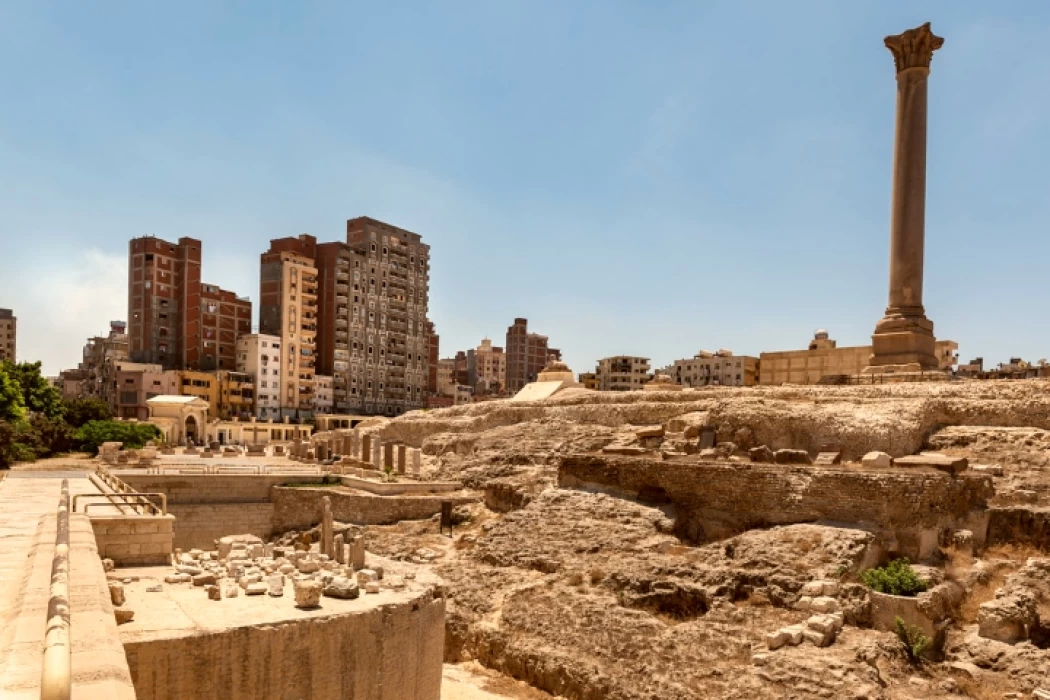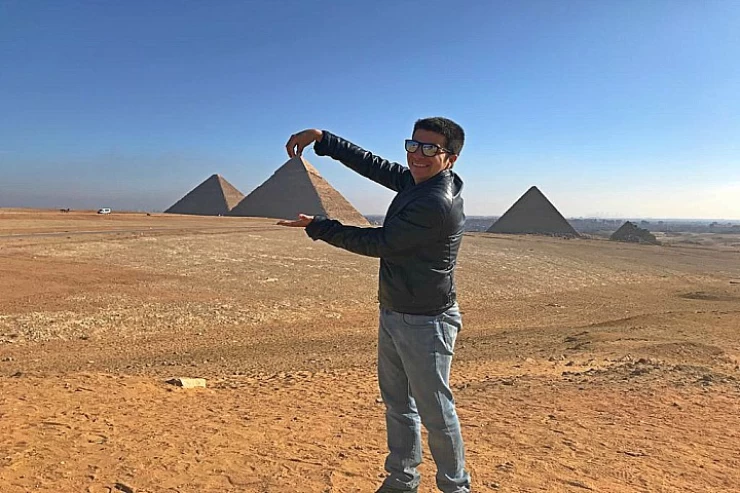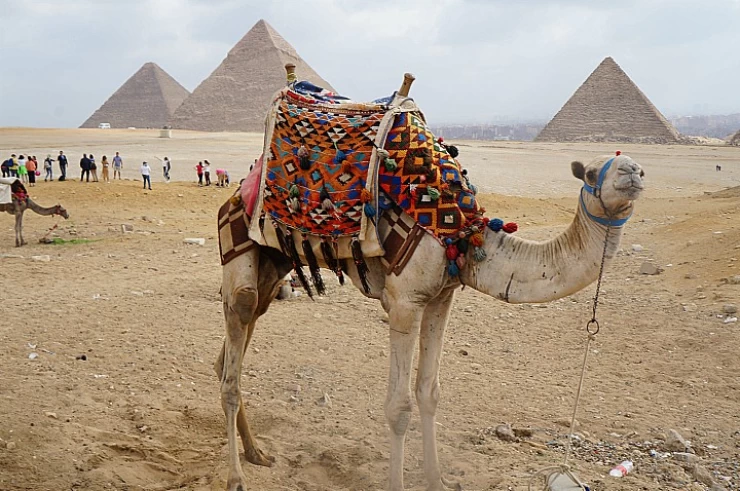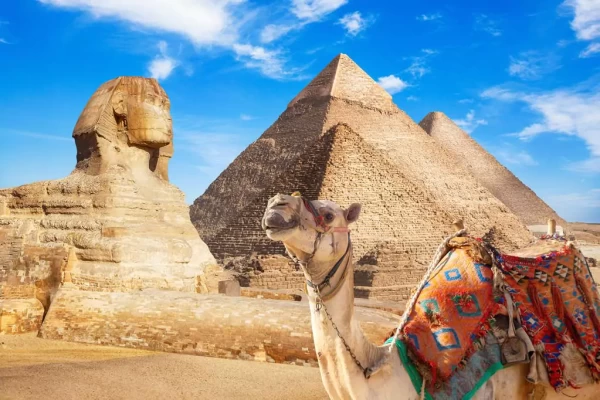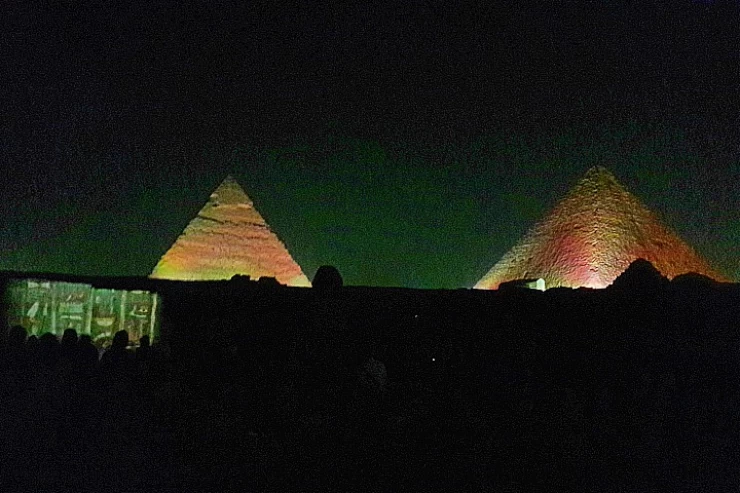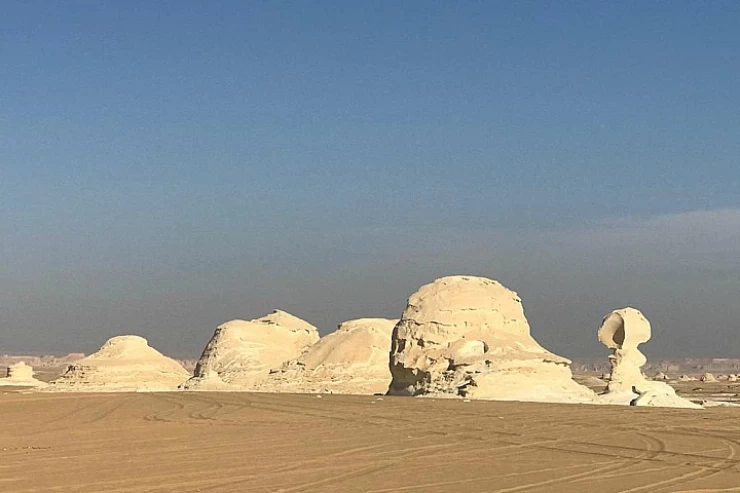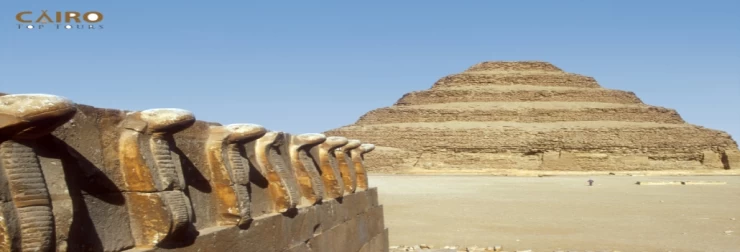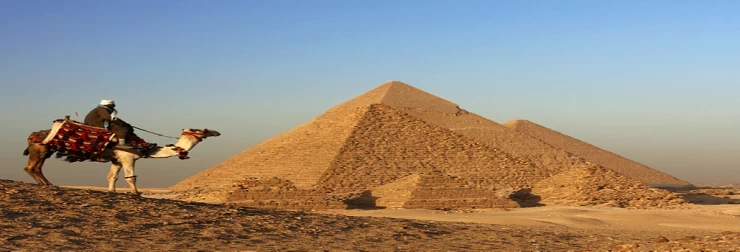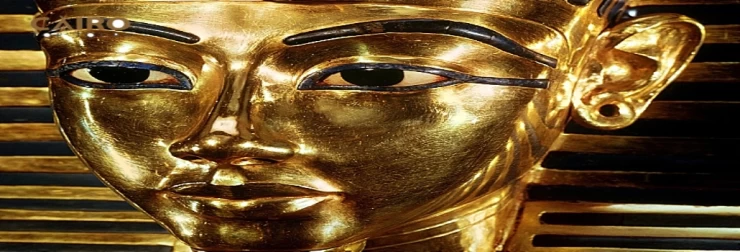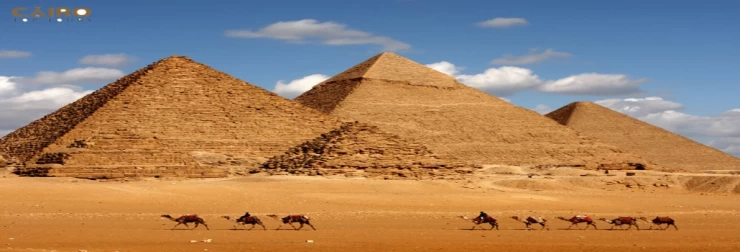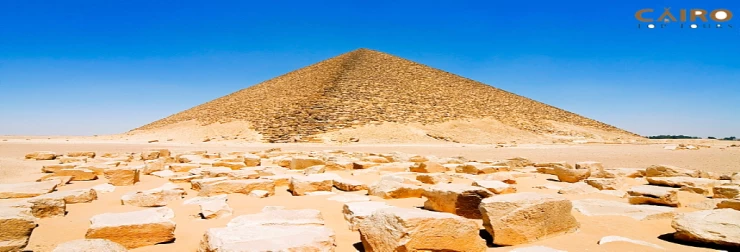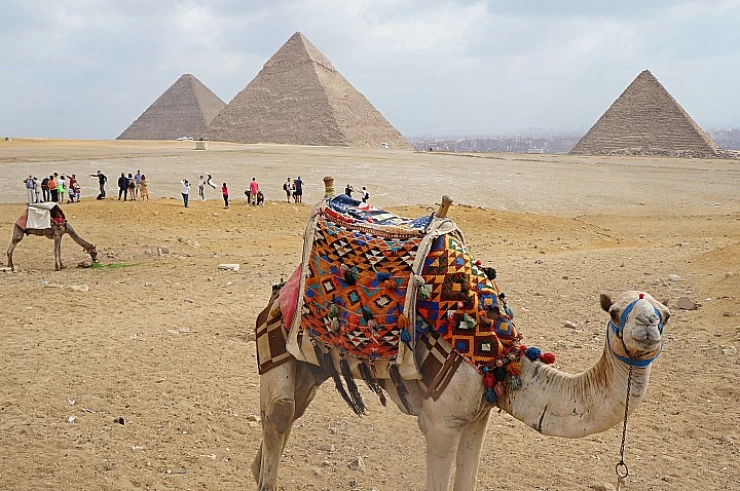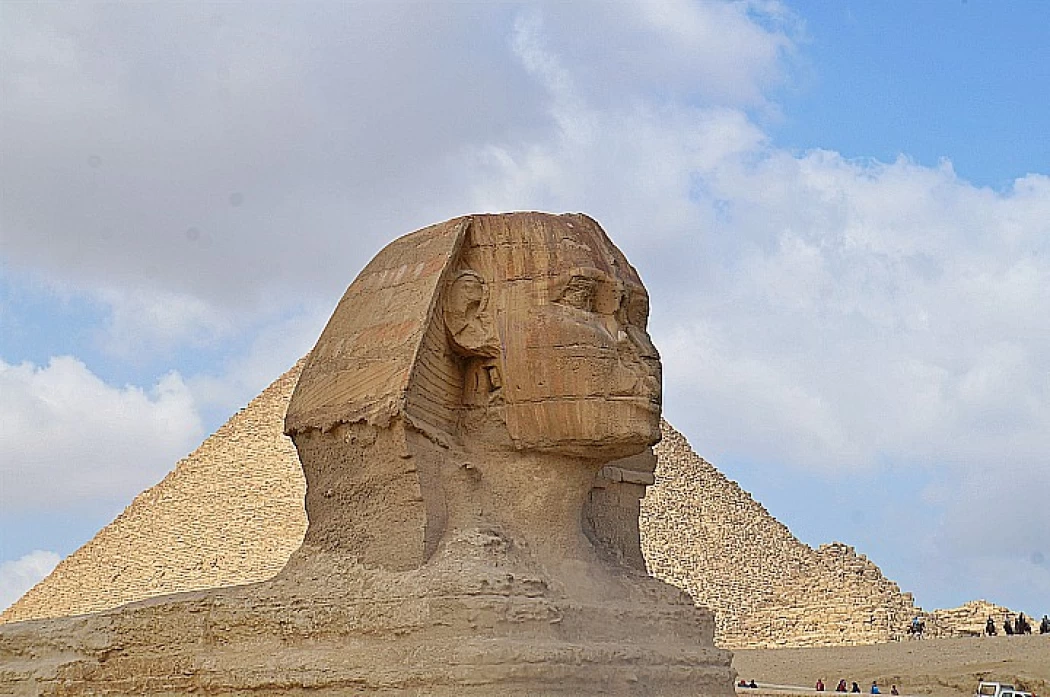
The great sphinx
The Great Sphinx is a huge stone sculpture carved from limestone, embodying a mythical creature with a human head and the body of a lion in a reclining position. Facing directly from West to East, the statue is located on the Giza plateau on the West Bank of the Nile in Giza, Egypt. It is believed that the facial features of the statue belong to Pharaoh Khafre. The original figure of the Sphinx was carved from the Adim Rock, later it was restored with limestone layers. The statue is 73 M (240 ft) long from claw to tail, 20 M (66 ft) high from the base to the top of the head, and 19 m (62 ft) wide at its hind feet.
The Sphinx is considered the oldest known monumental sculpture in Egypt and one of the most famous in the world. Archaeological evidence suggests that it was created by the ancient Egyptians in the era of the Old Kingdom during the reign of Pharaoh Khafre (approximately 2558-2532 BC).
The nose of the Sphinx was broken in uncertain circumstances, studies show that the nose was deliberately destroyed using sharp objects such as rods or a chisel. This contradicts the legend attributing the fracture to the artillery of Napoleon's troops during his campaign on Egypt in 1798, as drawings from before Napoleon's time show the disappearance of the nose. The historian Al-maqrizi also documented the absence of the nose in his writings dating back to the fifteenth century
The original name given by the ancient Egyptians to the Sphinx in the era of the Old Kingdom is unknown, as the construction of the temple of the Sphinx, its surroundings and perhaps the statue itself was not completed in that period, which leaves a lot of mystery about its cultural context. The Sphinx in the era of the new kingdom was perceived as the embodiment of the solar God "Hur-im-aht" (meaning "Horus of the horizon" in English, and"hermachis" in Greek). Pharaoh Thutmose IV (1401-1391 or 1397-1388 BC) explicitly referred to him in the famous dream painting.
As for the currently known name "Sphinx", it appeared in classical antiquity, that is, about 2000 years after the probable date of its construction. This name refers to a mythical creature in Greek mythology that has the head of a woman, a Falcon, a cat or a sheep, and the body of a lion with eagle wings. However, the Egyptian sphinx is different from this model, it is distinguished by a human head and the body of a lion without wings. The English word "Sphinx" is derived from the ancient Greek word "σρίγς" (pronounced "Sphinx"), believed to be taken from the verb "σρίγγω" (pronounced "spring"), which means "squeeze", a reference to the creature of Greek mythology who was strangling everyone who fails to solve his riddles.
Medieval Arab writers such as the historian Al-maqrizi called the Sphinx a name is taken from Coptic, which is "belhaib", "belhoba" or "belhawiya", a derivation of the ancient Egyptian name "Pahor" or "pahoron", which was associated with the Canaanite god "hauron", which was considered related to the Sphinx. He also appeared in French sketches as "ablohon", as in the work by Francois de la Boulaye Le GOZ. The current name "Sphinx", used in the Egyptian dialect, is a semantic-verbal harmonization of the Coptic name and translates as "terrifying father" or " father of awe
Archaeological evidence suggests that the Great Sphinx was carved around 2500 BC during the reign of King Khafre (the builder of the second pyramid in Giza). The statue was carved from the natural rock of the Giza plateau, which was also a source of stones used in the construction of pyramids and other monuments in the region. Egyptian geologist Farouk El-Baz suggests that the Sphinx's head may have been carved first from a natural formation known as "Yardang", a rock outcrop formed by wind erosion factors, and may sometimes take animal-like shapes. Elbaz also suggests that the moat surrounding the statue was later dug to complete the carving of the main body. Stones extracted from the vicinity of the statue were used to build a temple in front of it; however, neither the construction of the temple nor the surrounding area was completed, which indicates that the cult of the Sphinx was not established at that time.
Salim Hasan wrote in 1949 about the recent excavations in the area around the Sphinx, referring to these conditions by saying:
Taking into account all the factors, it seems that we should attribute the creation of this most magnificent statue in the world to Khafre. But with the following reservation: there is no contemporary inscription that directly connects the Sphinx with Khafre, so no matter how logical this interpretation may seem, we should consider it a circumstantial conclusion until decisive evidence is found that proves this sphinx
Excavations have shown that the creation of the temple of the Sphinx required the removal of part of the northern wall of the temple of Wadi Khafre, which suggests that the funerary complex of Khafre preceded the construction of the Sphinx and its temple. The location of the southern wall of the surrounding area also shows that the passage connecting the pyramid of Khafre and the valley temple already existed before the Sphinx was planned. In addition, the lower level of the base of the temple of the Sphinx shows that it was not earlier for the temple of Wadi Khafre.
Sometime during the era of the first transition, the Giza Necropolis was abandoned, and Quicksand covered the Sphinx up to his shoulders. The first documented attempt to excavate the Sphinx dates back to about 1400 BC, when the young Prince Thutmose IV (1401-1391 or 1397-1388 BC) gathered a team and, after considerable effort, managed to dig up the front paws of the Sphinx, erecting a shrine between them in which he placed the dream painting, a granite relief (probably it was a reused door sill from one of the temples of Khafre). When the painting was later discovered, the text inscribed on it had been damaged and parts of it had been lost. A fragment of the text mentions a dream in which the Sphinx appeared to Thutmose, saying:
"... The son of King Thutmose arrived and walked in the middle of the day, sat under the shadow of the Great God, fell asleep and fell asleep at the moment when RA is at the height [of heaven]. He found that the God of Divine Majesty speaks to him with his mouth, as a father speaks to his son, saying: Look at me, contemplate me, my son Thutmose; I am your father, Hor-m-sister-Khepri-Ra-atom; I grant you sovereignty over my kingdom, power over the living... Look at my current condition in order to protect all my full limbs. The desert sand on which I Lie has covered me. Save me, make everything in my heart come true."
The dream painting indicates the Association of the Sphinx with Khafre. However, this part of the text is not entirely intact:
"... We present him: Bulls... And all small vegetables; we will praise and save... Shh... The Made statue of Atom-Hor-m-sister."
In the nineteenth century, the Egyptologist Thomas Young added the symbol " ra "to the name" Kha", which appeared inside a broken cartridge on the plate, completing the name Khafre. But when the painting was rediscovered in 1925, these lines were completely damaged.
Later, it is believed that King Ramses II (1279-1213 BC) made a second attempt to excavate the statue.
In the era of the New Kingdom, the Sphinx became more closely associated with the solar God Hor-em-aht (in Greek: hermachis) or "Horus-at-sight". Also, Pharaoh Amenhotep II (1427-1401 or 1397 BC) established a temple near the Sphinx on the north-eastern side, which he dedicated to the worship of the God Hur-em-akht, about a thousand years after the sculpture was carved.
In the Greco-Roman era, Giza became a tourist destination as its monuments were considered ancient artifacts, some Roman emperors visited the Sphinx out of curiosity and for political reasons.
The Sphinx is depicted from the front, clearly showing its claws and a dream painting.
The sand was removed from the Sphinx back in the first century AD in honor of the Emperor Nero and the ruler of Egypt Tiberius Claudius balbellus. A huge staircase, more than 12 M (39 ft) wide, was built, leading to a corridor in front of the Sphinx's paws. A platform was placed at the top of the stairs, allowing to see inside the temple of the Sphinx. At the rear, another platform was placed adjacent to several additional steps. This staircase was dismantled during the excavations carried out by Emil Bariz in the period 1931-1932.
Pliny The Elder described the face of the Sphinx as being colored red and gave accurate measurements of the statue, saying:
In front of these pyramids lies the Sphinx, which is an even more amazing masterpiece of art, but remains shrouded in secrecy as the inhabitants of the region consider him a God. They believe that King Hermes was buried in it, and they claim that he was transported from a distant place. But the fact is that he was carved from a solid rock; his face was painted red as an expression of his reverence. The circumference of his head around the forehead is 102 feet, the length of his feet is 143 feet, while the height from his belly to the top of the snake on his head reaches 62 feet.
A historical painting dating back to 166 AD commemorates the restoration of the retaining walls surrounding the Sphinx. The emperor Septimius Severus was the last to have his name associated with the statue, around the year 200 ad. With the collapse of Roman power, the Sphinx was again buried under the sand.
Some non-Egyptian ancients considered the Sphinx to be a representation of the God Huron . The cult of the Sphinx continued until the Middle Ages. The Sabians considered Harran to be the burial place of Hermes the hermit. Arab writers described the Sphinx as an amulet protecting the territory from the desert. Al-maqrizi described him as the" Amulet of the Nile " as he believed that the flood cycle depended on him. Muhammad Al-Idrisi stated that those who sought bureaucratic positions in the Egyptian government were offering incense as an offering to the statue.
Writers and scientists over the centuries have documented their impressions and reactions when watching the Sphinx. Most of them were interested in providing general descriptions that often combined science, romance and mystery. One of the famous descriptions given by John Lawson Stoddard in the XIX-XX centuries is:
Sphinx it is the foot of the Sphinx that excites us when we look at it, because by itself it does not possess any charm. The waves of the desert rose to his chest, as if enveloping the beast in a shroud of gold. The face and head were mutilated by Muslim fanatics. The mouth, the beauty of whose lips was admired, is now expressionless. However, the Sphinx remains majestic in its solitude, obscured by the mystery of unknown eras, as a remnant of the monuments of ancient Egypt standing reverently and silently in the face of the terrible desert – a symbol of Eternity. Here he is contending with time for the Empire of the past; he keeps staring into the future that will remain far away when we, like all those who preceded us and looked at his face, have lived our short life and the Sphinx has disappeared
Many European observers from the XVI to the XIX centuries described the Sphinx in various qualities, some of them considered it a woman with a feminine face, neck and chest. Among these were Johannes helferich (1579), George Sandys (1615), Johann Michael vanslip (1677), Benoit de Maillet (1735), and Elliot Warburton (1844).
Most of the early Western images were illustrations in printed books, executed by professional engravers based on earlier photographs or original drawings from the authors, and these original drawings were often lost over time. Seven years after visiting Giza, Andre thevet (in his book "cosmographie du Levant", 1556) described the Sphinx as ""the head of a huge statue, the sculpture of which was ordered by ISIS the daughter of inachus, who was the beloved of Jupiter"". Athanasius Kircher (who never visited Egypt) depicted the Sphinx as a Roman statue in his book "The Tower of Babel" (1679). And in the description of Johannes helferich (1579), the Sphinx was a woman with a slender face, a round chest and a straight wig. While George Sandys stated that the Sphinx was a prostitute, Balthazar de monconis interpreted the headdress as a hair net. While Francois de la Boulay Le GOZ described the Sphinx hairstyle as a round one surrounded by a huge collar.
Richard Pocock, in his description of the Sphinx, relied on a drawing by Cornelis de Bruyn (1698) with some minor modifications, and was closer to the actual shape of the Sphinx than any previous description. It is noteworthy that the printed copies of Norden's sketches of his trip to Egypt and Nubia (1755) clearly showed that the nose was missing.
In 1817, the first modern archaeological excavations, supervised by the Italian Giovanni Battista Caviglia, revealed the entire chest of the Sphinx.
And at the beginning of 1887, other parts of the statue such as the chest, claws, altar, as well as the plateau, became fully visible. Ladders were discovered, accurate measurements of the giant statue were taken. The height from the lowest rungs turned out to be up to one hundred feet, and the distance between the Claws is thirty-five feet in length and ten feet in width. An earlier altar was also found at the site, and a painting by Thutmose IV was discovered that records a dream in which he ordered to remove the sand that had accumulated around the site of the Sphinx at that time.
Among the people who worked to remove the sand from around the Great Sphinx is Eugene grebo, the French director of the Antiquities Authority
Egyptologists and early prospectors were divided in their opinions regarding the age of the Sphinx and the temples associated with it.
The Sphinx with the lens of the Italian photographer Beniamino facchinelli, circa 1850-1885
In 1857, Auguste Mariette, the founder of the Egyptian Museum in Cairo, discovered an inventory painting estimated to date from the twenty-sixth dynasty (C.664-525 BC), which tells how Cheops found the Sphinx already buried under the sand. And although some parts of the painting may be true, the text contradicts archaeological evidence, so it is considered a belated historical revision or even a deliberate forgery of local priests with the aim of giving ancient history to the contemporary Temple of ISIS, which he did not originally own. Such attempts were common in that period when temples and religious institutions were competing for political attention and financial donations.
In 1883, Flinders Petrie wrote about the controversy about the age of the Wadi Khafre temple and the Sphinx, noting that some believed that the history of the Granite temple was older than the fourth dynasty, while recent discoveries strongly suggested that it was built only during the reign of Khafre in the Fourth Dynasty.
Gaston Maspero, a French Egyptologist and the second director of the Egyptian Museum in Cairo, conducted a survey of the Sphinx in 1886, and concluded that since the dream painting contains the cartridge of Khafre in the thirteenth line, the Sphinx must be older than Khafre and his ancestors. Maspero went on to say that the Sphinx is "the oldest monument in Egypt," and it probably dates back to about 2575-2467 BC.
Ludwig Borchardt, for his part, attributed the Sphinx to the Middle Kingdom era, saying that the special features seen on the Sphinx are unique to the Twelfth Dynasty and that the Sphinx resembles Amenemhat III.
Wallis Budge agreed that the Sphinx is older than the reign of Khafre, and noted in his book "The Gods of the Egyptians" (1904): ""this wonderful thing [the Great Sphinx] existed in the days of Khafre, or khafren, and it is likely that it is much older than his reign and dates back to the end of the antique period [about 2686 BC]"."
As for Selim Hassan, he concluded that the Sphinx was erected after the completion of the Khafre Pyramid Complex.
Reiner Stadelmann, former director of the German Archaeological Institute in Cairo, examined the characteristic iconic features of the headdress (mongoose) and the beard of the Sphinx, which became separate, and concluded that these features refer more to the Pharaoh Cheops (2589-2566 BC), known to the Greeks as Cheops, the builder of the Great Pyramid of Giza and the father of Khafre. Stadelman supported his opinion by stating that the Khafre road was built so that it fit into an already existing structure, which means that this structure could only be a sphinx due to its location.
In 2004, Vasil Dobrev from the French Institute of Oriental archeology in Cairo announced that he had discovered new evidence suggesting that the Great Sphinx may be the work of the relatively unknown Pharaoh djedef Ra (2528-2520 BC), half-brother of Khafre and son of Cheops. Dobrev suggested that the grandfather of RA built the Sphinx in the image of his father Cheops, considering him the embodiment of the sun god Ra in order to restore respect for their dynasty. He added that the road connecting the pyramid of Khafre and the temples was built around the Sphinx, which suggests that it already existed at that time. Egyptologist Nigel Strudwick responded to Dobrev: "" this is not ruled out, but I need further clarification, such as why he believes that the pyramid at Abu Rawash is a Solar Temple, which I doubt. I have never heard before that the inscriptions in the corner of El-Erian refer to the blasphemy of RA. I still believe more strongly in the traditional theory that goes back to Khafre or the newer opinion that refers to Khufu""
Geologist Colin Reeder suggested that water runoff from the Giza plateau is responsible for differential erosion on the walls of the Sphinx zone. Due to the significant changes in the hydrological characteristics of the area due to quarrying, Reeder believes that this indicates that the Sphinx predated quarrying (and therefore the pyramids). He points to the massive stones in part of the Sphinx temple, as well as the alignment of the road with the pyramids and interruptions in the quarries, as evidence that the pyramids took into account the alignment of some pre-existing structures, such as the Sphinx when building them, and that the temple of the Sphinx was built in two distinct stages. Raeder argues that such erosion occurred relatively quickly and suggested that the Sphinx was not a few centuries older than the current archaeological evidence suggests, suggesting that it dates back to the late Predynastic or early dynastic era, when the ancient Egyptians were already known for their ability to masterfully build.
In 1931, Egyptian government engineers repaired the head of the Sphinx after part of the headdress fell off in 1926 as a result of corrosion, which also penetrated deep into its neck. This repair, which raised some questions, was carried out by adding a concrete collar between the headdress and the neck, changing its original appearance. Many renovations were carried out on the stone base and The Rock body in the eighties, and then these repairs were repeated again in the nineties.
The nomolitic limestone of the Sphinx region consists of layers with varying resistance to erosion (which is most often caused by wind and wind-borne sand), which leads to the pronounced uneven deterioration of the Sphinx's body. Since the lower part of the body, including the legs, is made of hard rocks, while the body of the animal up to its neck consists of softer layers that have undergone significant disintegration. As for the layer on which the head is carved, it is much more rigid.
There are also a number of "closed" columns inside and under the body of the Sphinx, it is believed that they were dug by treasure hunters and tomb robbers.
Examination of the Sphinx's face shows that long rods or a chisel were hammered into the nose area, one above the bridge and the other below the nostril, and then used to remove the nose towards the south, as a result of which it was lost, the width of the lost nose until today is one meter. There are many folk tales explaining the destruction of the nose, aimed at giving an answer about where he went or what happened to him. One such anecdote is due to the artillery shells fired by the armies of Napoleon Bonaparte, but this is not true, since the drawings of Frederick Louis Norden in 1737 showed that the nose was missing sixty years before the arrival of Napoleon.
A limestone fragment of the beard of the Sphinx in the British Museum, XIV century BC.
Some Arab authors of the tenth century suggest that the damage to the nose was the result of iconoclastic attacks. In addition, some of them stated that the damage was the work of the Mamluks in the XIV century. According to the son of Qazi Shahba, it was Muhammad ibn Sadiq ibn Muhammad al-Tabrizi al-Masri (d.1384) who desecrated the sphinxes in the "Qanater Al-Siba".
The Arab historian Al-maqrizi, writing in the early fifteenth century, attributes the loss of the nose of the Sphinx to Muhammad Sa'im Al-Dahr, a Muslim Sufi, who was said to have found local peasants making offerings to the Sphinx in the hope of improving their crops, so he mutilated the face of the statue as an attempt by him to fight the cult of Icons (Idols). According to Al-maqrizi, many residents of the area believed that the excess of sand that covered the Giza plateau was a divine punishment for this act of vandalism by Al-Dhahr. Abd al-Salam Al-munufi (1443-1527) also noted that the crusade on Alexandria in 1365 was a divine punishment for Muhammad fasting Al-Dahr breaking the nose of the Sphinx.
In addition to the missing nose, it is believed that the Sphinx had a ritual pharaonic beard (chin), although this beard was probably added after the construction of the original Statue. Egyptologist Vasil Dobrev suggested that if the beard had been an original part of the Sphinx, it would have damaged the statue's chin when it fell.
Visible remnants of red pigment were also found on parts of the Sphinx's face, traces of yellow and blue pigment were found in other places of the statue, based on this, Egyptologist Mark Lehner suggested to suggest that the statue was once decorated with bright colors resembling the colors of comic books.
A hole in the Sphinx's head
A large incision runs through the waist of the Sphinx, before modern restorations in 1926
Johann Helfrich in his travels between 1565 and 1566 described how a priest entered the head of the Sphinx, making his voice sound as if coming from the statue itself.
Paintings from the era of the New Kingdom show the Sphinx wearing a crown, and if this crown really existed, then this hole in the head may have been designed to fix it. Later, Emil Bariz closed this hole using a metal cap in 1926.
Bering hole
In 1837, Howard Weiss asked John Shay Bering to dig a tunnel in the back of the Sphinx just behind the Cape. The diggers got stuck at a depth of 27 feet (8.2 M), and when they tried to free the rails using explosives, they caused additional damage. In 1978, the hole was cleaned and a fragment of the headdress (pharaonic mongoose) of the Sphinx was found among the ruins.
The big crack
A secret door after restoration reaches the main crack.
A large natural fissure cuts through the bedrock in the center of the Sphinx's body, it was first discovered by Auguste Mariette in 1853.
The width of the incision at the top of the back reaches two meters (6.6 ft). In 1926, Emil Bariz fixed the sides of the crack using iron rods, limestone and cement, and installed an iron door on top of the crack. While the sides of the fissure appear to have been artificially leveled, the bottom remains an irregular bedrock, protruding about one meter (3.3 ft) from the surrounding floor, and continuing at a very narrow depth.
Posterior fissure
In 1926, Emil Bariz supervised the removal of the sand surrounding the Sphinx, revealing an opening leading to a tunnel at ground level on the north side of the rear of the Sphinx. The hole was later closed with a layer of masonry and the matter was almost forgotten.
More than fifty years later, three old men who worked as chain carriers during the cleaning operation remembered the existence of this passage. This led to the reopening and excavation of the tunnel in 1980.
The corridor consists of an upper section and a lower section, which are almost perpendicular to each other:
Upper section: ascends to a height of 4 m (13 ft) above ground level in a north-westerly direction. It runs between the outer building layer and the underlying rocky body of the Sphinx and ends in a cavity 1 m (3.3 ft) wide and 1.8 m (5.9 ft) high. The roof of the cavity consists of modern cement, which most likely leaked from the gap between the masonry and the underlying rock at a height of about 3 m (9.8 ft) above it.
Bottom section: steeply sloping into the bedrock towards the Northeast, for a distance of about 4 m (13 ft) and a depth of 5 M (16 ft). The passage ends in a clogged pit at the groundwater level. The passage at the entrance is 1.3 m (4.3 ft) wide, narrowing to about 1.07 M (3.5 ft) towards the end. A piece of tin foil and the base of a modern ceramic water jar were found among the sand and stone fragments. The clogged bottom contained modern filler, including more tin foil, modern cement and a pair of shoes.
It is likely that the entire passage was dug from top to bottom, starting from a high point at the back of the Sphinx, and the current access point at ground level was created much later.
In his memoirs (February 27 and 28, 1837), Weiss noted that he was "digging" near the tail, which suggests the possibility that he was the one who initiated the construction of this tunnel, since no other tunnels have been discovered at the site. Another explanation is that the passage has an older origin, perhaps it was an exploratory tunnel or an unfinished tomb pillar.
A cavity on the north side
A photograph from 1925 shows a man standing below ground level in a cavity inside the underlying rocky body of a sphinx. This cavity was closed during restorations between 1925 and 1926.
A gap under the large building fund in the South
Partial excavation of the Great Sphinx circa 1883
Another opening is probably located at ground level below the large masonry box located on the south side of the Sphinx.
The space behind the dream painting
Behind the dream panel, between the Sphinx's Paws, is a space enclosed by a cement roof and an iron beam. This space was also provided with an iron door to protect it.
Keyhole column
In the northwestern corner of the Sphinx area, a square-shaped pillar is located along the northern back Palm. This pillar was cleaned during the excavations of Zahi Hawass in 1978, and is 1.42 meters wide, 1.06 meters long (4.7 × 3.5 ft) and almost 2 meters deep (6.6 ft). Mark Lehner called it a" keyhole column " because there are cuts on its upper edge that take the shape of the inverted bottom of a traditional keyhole from the Victorian era. It is believed that the column served as an unfinished tomb
Many theories have been put forward to explain the origin and identity of the Sphinx, however, they lack sufficient evidence or contradict known archaeological facts, which makes them classified within the scope of pseudohistory and unreliable archeology.
Ancient astronauts-Atlantis
Main article: Ancient Astronauts
Sphinx direction: the Sphinx turns from West to east towards sunrise, which is in harmony with the ancient Egyptian solar ritual. The Orion correlation theory suggests that its orientation was intended to face the constellation Leo during the vernal equinox around 10,500 BC. However, this theory is considered by academics to be part of pseudoarchaeology, due to the absence of any textual or archaeological evidence supporting this assumption.
Water erosion hypothesis: the water erosion hypothesis states that the prominent erosion on the Sphinx and the surrounding area was caused by prolonged heavy rains, suggesting that the Sphinx may be older than the reign of Pharaoh Khafre. This hypothesis was proposed by Rene Schwaller de Lubitz, John Anthony West, geologist Robert M. Shush . But the scientific mainstream considers this theory to be part of pseudoarchaeology, as it contradicts the available archaeological, climatic and geological evidence.
Secret rooms under the Sphinx: the idea of hidden rooms under the Sphinx has long intrigued the imagination of many believing researchers of spirituality such as Harvey Spencer Lewis. In the thirties, Edgar Cayce predicted that the "Hall of records", allegedly containing science and knowledge from Atlantis, would be discovered under the Sphinx by 1998. Although these predictions caused a lot of controversy in the nineties, the momentum lost its effect when no evidence was found to support the veracity of these claims.
Hypothesis that the Sphinx was a statue of Anubis: Robert Temple proposed a theory that the Sphinx was originally a statue of the god Anubis (the God of funerals), and that it was later re-sculpted to bear the features of a pharaoh of the Middle Kingdom (probably Amenemhat II). Temple based his theory on some details such as the style of eye makeup and the folds of the headdress that, in his opinion, correspond to this period.
Until the early twentieth century, the Sphinx's face was sometimes referred to as having "Negro" features, in the context of historical racial theories that today are abandoned and are not considered scientifically correct.
Latest Articles
Admin
Neper God Of Grain
Neper was the deity of grains, particularly cereals that were important in Ancient Egypt, such as wheat and barley. It was stated that he foretold when the crops would grow, be harvested, and disappear.
Admin
Djoser
Djoser was an ancient Egyptian pharaoh of the 3rd Dynasty during the Old Kingdom and was the founder of that epoch. He is also known by his Hellenized names Tosorthros (from Manetho) and Sesorthos (from Eusebius). He was the son of King Khasekhemwy and Queen Nimaathap, but whether he was also the direct successor to their throne is unclear. Most Ramesside king lists identify a king named Nebka as preceding him, but there are difficulties in connecting that name with contemporary Horus names, so some Egyptologists question the received throne sequence. Djoser is known for his step pyramid, which is the earliest colossal stone building in ancient Egypt
Admin
Kom Al Dikka Alexandria
Kom El Deka, also known as Kom el-Dikka, is a neighborhood and archaeological site in Alexandria, Egypt. Early Kom El-Dikka was a well-off residential area, and later it was a major civic center in Alexandria, with a bath complex (thermae), auditoria (lecture halls), and a theatre.
Admin
The God Anuket
Anuket, in Egyptian religion, the patron deity of the Nile River. Anuket is normally depicted as a beautiful woman wearing a crown of reeds and ostrich feathers and accompanied by a gazelle.
Admin
The Red Chapel of Hatshepsut
The Red Chapel of Hatshepsut or the Chapelle rouge was a religious shrine in Ancient Egypt. The chapel was originally constructed as a barque shrine during the reign of Hatshepsut. She was the fifth pharaoh of the Eighteenth Dynasty from approximately 1479 to 1458 BC.
Admin
The Serapeum of Alexandria
The Serapeum of Alexandria in the Ptolemaic Kingdom was an ancient Greek temple built by Ptolemy III Euergetes (reigned 246–222 BC) and dedicated to Serapis, who was made the protector of Alexandria, Egypt. There are also signs of Harpocrates. It has been referred to as the daughter of the Library of Alexandria.
